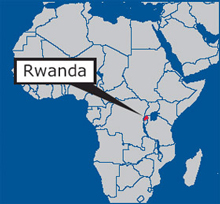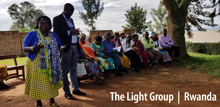Retired NICC employee joins delegation to Rwanda to study peace and reconciliation efforts
Thursday, May 16, 2019
RWANDA, Africa—The genocide in Rwanda and the atrocities committed from April 7 – July 15, 1994, shocked the entire world. Mass murder, rape, dismemberment of citizens and the displacement of Rwandans from their homes marked the three-month conflict, leaving a devastating legacy to future generations and an estimated 800,000 – one million killed.
Today, three-quarters of Rwanda’s population is under 30 years of age. Yet, continuing efforts toward reconciliation between the victims and the perpetrators are slowly rebuilding trust and hope in the African nation, observed Deb Seiffert, retired Northeast Iowa Community College Library Resources Coordinator at the Peosta campus.
 Seiffert joined a 29-member delegation from March 10 – March 23 as a member of the Peace and Justice Program, a mission branch of Presbyterian Church USA, of which her church, Westminster Presbyterian Church in Dubuque, is a member.
Seiffert joined a 29-member delegation from March 10 – March 23 as a member of the Peace and Justice Program, a mission branch of Presbyterian Church USA, of which her church, Westminster Presbyterian Church in Dubuque, is a member.
“The goal of the journey was to learn more about the genocide in Rwanda that occurred in 1994, so that it doesn’t happen again, to understand what happened, why it happened and how the Rwandan people are making efforts at reconciliation,” Seiffert explained. “Beginning on April 7, 1994, Hutus used machetes, clubs with nails embedded in them, grenades and guns, to slaughter around one million men, women, children and elderly in 100 days.”
Some history and background of the nation is helpful to understanding the conflict. Originally the term Tutsi meant someone with many cows, and the term Hutu meant someone who worked the land. They spoke the same language and could interchange between these two groups. When Rwanda was colonized by Germany in 1894, their king was a Tutsi with chiefs in the outlying land who were both Tutsi and Hutu. Belgium was awarded Rwanda by a League of Nations mandate after World War I. Belgium’s policy to maintain power was to cause divisions. Although the minority, the Tutsis were recognized as the elite and because their physical traits were more European, they were thought to be more intelligent. The Belgians then introduced a card system identifying who were Tutsi and who were Hutu by these physical traits. As Tutsis were treated more favorably, the Hutus became jealous and angry. The Tutsi King wanted to provide more equality, but he mysteriously died. Hutus, backed by Belgium, rose up against the Tutsis and gained leadership over the country. Widespread discrimination against the Tutsi began fueling an intensifying conflict between the two groups.
 In 1986, the Tutsis formed the Rwandan Patriotic Front (RPF) to wage war against the majority Hutu population. In 1993, under international pressure, Rwandan President Juvénal Habyarimana signed a power sharing agreement with the RPF, called the Arusha Accord. On April 6, 1994, an airplane with Habyarimana on board was shot down. The Hutu extremists blamed the RPF through radio propaganda although in actuality it was the Hutus who felt Habyarimana sold them out. Machetes, spiked clubs, grenades and rifles were handed out to the Interahamwe, the civilian militia. On April 7, with urgings from the Hutu leaders and the radio, the civilians went out to massacre their Tutsi neighbors.
In 1986, the Tutsis formed the Rwandan Patriotic Front (RPF) to wage war against the majority Hutu population. In 1993, under international pressure, Rwandan President Juvénal Habyarimana signed a power sharing agreement with the RPF, called the Arusha Accord. On April 6, 1994, an airplane with Habyarimana on board was shot down. The Hutu extremists blamed the RPF through radio propaganda although in actuality it was the Hutus who felt Habyarimana sold them out. Machetes, spiked clubs, grenades and rifles were handed out to the Interahamwe, the civilian militia. On April 7, with urgings from the Hutu leaders and the radio, the civilians went out to massacre their Tutsi neighbors.
The seminar to Rwanda included visits to two very emotionally-powerful memorials about the genocide. The first she witnessed was the Kigali Genocide Memorial which housed a modern historical view of the genocide and included a children’s room that displayed photos of children, infants and toddlers with their name, ages, what foods they liked and how they played, ending with how they were killed. The seminar group laid white roses on the mass gravesites where 250,000 victims were buried with dignity.
A second memorial housed at the Murambi Genocide Memorial Centre, formerly planned to be a school in southwestern Rwanda, had 50,000 victims buried respectfully in a mass grave. Some of the bodies of genocide victims were preserved in lime and displayed in several classrooms as a monument to prove this happened.
“Memorials serve an important role, so that people do not forget the genocide and the atrocities committed in Rwanda. The people of Rwanda don’t want it to happen again. The country is trying to rebuild the spirit destroyed by the genocide. Many survivors suffer from Post-Traumatic Stress Disorder (PTSD)”, Seiffert said.
 During Seiffert’s visit, there was much discussion of the church’s role in the genocide. “Rwanda was 90 percent Christian when this occurred; how could this happen? To oversimplify the answer, it was due to Hutu leaders instilling fear and urging the people to protect themselves, as well as the church’s silence to what was happening, that made people believe what they were doing was okay,” Seiffert stated. “Today, there is no longer a card system, all are Rwandans. Many of the victims and the perpetrators of war crimes, are working through a process of forgiveness and confession. A group called The Light Group organized by the churches, gives hope for the future through this painful process. The initiative helps perpetrators of war crimes to accept and understand that what they did was wrong, and to ask for forgiveness. The group helps victims meet the ones who had committed these crimes and find the capacity to forgive,” she added.
During Seiffert’s visit, there was much discussion of the church’s role in the genocide. “Rwanda was 90 percent Christian when this occurred; how could this happen? To oversimplify the answer, it was due to Hutu leaders instilling fear and urging the people to protect themselves, as well as the church’s silence to what was happening, that made people believe what they were doing was okay,” Seiffert stated. “Today, there is no longer a card system, all are Rwandans. Many of the victims and the perpetrators of war crimes, are working through a process of forgiveness and confession. A group called The Light Group organized by the churches, gives hope for the future through this painful process. The initiative helps perpetrators of war crimes to accept and understand that what they did was wrong, and to ask for forgiveness. The group helps victims meet the ones who had committed these crimes and find the capacity to forgive,” she added.
Other initiatives she visited include a secondary technical school in Rubengera to train Rwandans carpentry skills to bring themselves out of poverty. Another is a Peace Building Program at the Presbyterian Institute of Art and Social Sciences, educating people to become leaders in confronting divisiveness and building reconciliation. A Peace Club at a high school works with youth to inspire a new generation to work together to build their futures and the nation’s. “The children are Rwanda’s future,” Seiffert said. “We met many smiling, curious youth with joy in their eyes.”
The conflict and its tragic aftermath were preventable, and Seiffert believes that encouraging divisions in nations throughout the world can have disastrous consequences.
“People everywhere are encountering deep divisiveness that work against the cause of peace and reconciliation. We can accomplish so much more together if we stop emphasizing our differences as negatives and seeing the positives. If we listen to each other’s views, I believe we can find that we have a lot in common. We have the same hopes, fears, longings; that we want a safe place for our families, a roof over our heads, food on the table and a purpose to our lives.”
Deb Seiffert is hosting a discussion on the book As We Forgive: Stories of Reconciliation from Rwanda by Catherine Larson on June 9 and 23. Call (563) 583-1729 for more details.
Seiffert served as Learning Resources Coordinator at Northeast Iowa Community College from 1980 to 2016.
